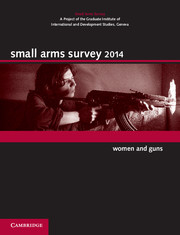Book contents
- Frontmatter
- Foreword
- Contents
- About the Small Arms Survey
- Notes to readers
- Acknowledgements
- Introduction
- Chapter 1 In War and Peace: Violence against Women and Girls
- Chapter 2 Converging Agendas: Women, Peace, Security, and Small Arms
- Special Feature. Women behind the Gun: Aiming for Equality and Recognition
- Chapter 3 Breaking New Ground?: The Arms Trade Treaty
- Chapter 4 Trade Update: Transfers, Retransfers, and the ATT
- Chapter 5 Countdown to Catastrophe: The Mpila Ammunition Depot Explosions
- Chapter 6 Across Conflict zones: Ammunition Profiling
- Chapter 7 Signs of Supply: Weapons Tracing in Sudan and South Sudan
- Chapter 8 On the Record: Illicit Weapons in the the United States
- Index
Chapter 1 - In War and Peace: Violence against Women and Girls
Published online by Cambridge University Press: 05 July 2014
- Frontmatter
- Foreword
- Contents
- About the Small Arms Survey
- Notes to readers
- Acknowledgements
- Introduction
- Chapter 1 In War and Peace: Violence against Women and Girls
- Chapter 2 Converging Agendas: Women, Peace, Security, and Small Arms
- Special Feature. Women behind the Gun: Aiming for Equality and Recognition
- Chapter 3 Breaking New Ground?: The Arms Trade Treaty
- Chapter 4 Trade Update: Transfers, Retransfers, and the ATT
- Chapter 5 Countdown to Catastrophe: The Mpila Ammunition Depot Explosions
- Chapter 6 Across Conflict zones: Ammunition Profiling
- Chapter 7 Signs of Supply: Weapons Tracing in Sudan and South Sudan
- Chapter 8 On the Record: Illicit Weapons in the the United States
- Index
Summary
INTRODUCTION
While the use of violence against women and girls (VAWG) as a ‘weapon of war’ has received widespread international attention, researchers have only recently begun to assess its prevalence in peacetime and transitioning societies. The World Health Organization (WHO) finds that 36 per cent of women aged 15–69 worldwide have experienced either non-partner sexual violence or physical or sexual violence by an intimate partner, or both (WHO, 2013, p. 20). Analysts have also increasingly documented the role of guns in the context of intimate partner violence against women.
VAWG is a global phenomenon, but its prevalence varies depending on a range of individual, family, community, and social factors whose interaction is not well understood. Among the broadest set of influences on VAWG are social norms that inform how men and women regard and interact with one another. Widely held attitudes about the roles of women in the home and community, the acceptability of punishing women who deviate from expected behaviour, and norms surrounding the use of guns and violence as a means of resolving conflict are among the many factors that influence VAWG.
After a brief global survey, this chapter reviews available VAWG rates (including gun-related VAWG), relevant social norms, and programming responses in Liberia and Nepal, two countries emerging from the long shadow of conflict. The devastating civil war in Liberia killed an estimated 250,000 people; the collective activism of women was an important element in its ultimate resolution (Foster et al., 2009, pp. 3, 19).
- Type
- Chapter
- Information
- Small Arms Survey 2014Women and Guns, pp. 8 - 33Publisher: Cambridge University PressPrint publication year: 2014



